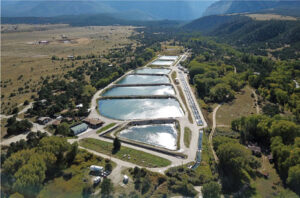By Forrest Whitman
Colorado folks, especially here in the Upper Arkansas Valley, used to be called “Colorado nice.” I still hear that sometimes, but not often. There are more of us here and that may result in less “nice” and more “grumpies.” Population booms lead to some positives and some negatives, but there’s no argument that our boom is here.
All along the valley from Cañon City to Leadville we experience population rapid growth. Best estimates are between a 14 to 20% increase just over the last decade. The population boom gives us positives, like better internet and diverse restaurants and soon to be more drama and music events. Another positive will be better rail travel options.
A similar boom happened here between about 1879 and 1885. The cause of that boom was easy to see. The railroad came to town. The next railroad to come won’t be that dramatic. But it will be significant.
A new commuter railroad is coming. The state rail plan, with around a billion dollars of federal funding this time, calls for regular commuter service. Our front range rail plan is one of AMTRAK’S top three budget items. Trains running Trinidad to Wyoming (via Union Station, Denver) and spur service to long distance trains in La Junta are closer than I could have imagined two years ago.
We don’t have the stimulus check in hand yet, but things look very good this time. The Front Range Rail Commission is 100% positive about it. Not only that, the Colorado legislature and governor are on board with strongly increased funding for transportation. If need be, some of that money could be leveraged into the federal and AMTRAK commuter plan.
We have seen this kind of boom before. In 1875, Dr. William Bell, friend of railroad owner General Palmer and one mastermind of the Denver and Rio Grande Railroad, predicted positives. Big money, much of it eastern, followed local money into our newly-opened rich region. Once the railroad came there was no stopping the explosion of population and wealth. Life was better just as Bell predicted. We did get better education and health care, as well as access to markets, even during mud season.
In that earlier boom we were a distant part of Colorado’s newly-forming metropolitan corridor. We became a corridor leading to centers in Colorado Springs and Denver. Today’s boom will be as close as my laptop. The physical corridor no longer exists, but the new corridors are as close as the web.
As population boomed in the 1870s and 80s, many found it hard to adjust while others welcomed the changes. The Ark Valley began to see immigrants from Central Europe and places like Italy. Traditional small town stores often failed, but bigger stores and catalog sales offered a wider variety. The post office gave better service and the telegraph did too, opening wider possibilities. Ranching still was vital, but no longer king. Old time “pop and mom” mining gave way to corporate mines, but that sometimes led to union gains and better pay. The railroad boom brought pluses and minuses.
To get some idea of how big the boom of the 1870s and ’80s was, consider box cars. From 1875 till 1882 the D&RG railroad shops built 2,500 ten-ton cars. They were big cars at 24 feet long. Then by the late 1880s the road also needed 200 huge 20-ton cars which were 30 feet long. Traffic in Salida boomed to eventually 200 trains a day.
Then as now, there was inevitable change in human interaction. Back then some complained in local papers we were less “nice.” Rapid change shifted family structures in that boom too. Traditional family hierarchies failed as young people, particularly women, could take the train to Denver. People began to see themselves as part of a bigger state. Kids went to school outside the region. Marriages happened in bigger parts of the world.
Several factors are pulling us into a new paradigm now. The coming railroad commuter service will be only part of the picture. 4G and 5G are coming and so are more young professionals. They are moving to the Upper Ark Valley for the amenities here.
We are now a part of the Colorado metroplex. Corporate head offices are still often centered in Denver, but even the head offices are migrating out. Those who work from home must occasionally travel to the center of things and a few will still not be able to work from home, but that will become easier on commuter rail. Improved transportation makes things happen and that’s more for better than worse.
The new commuter rail will not be stopped by snow on Kenosha Pass or traffic clog on intestate highways. Fast, reliable commuter rail will be fed by the web of buses reaching small towns in the Ark Valley like Del Norte, Center and Monte Vista just as they do now. Places like Pueblo and Trinidad will be commuter rail passenger centers with four to five trains a day. The current bus service from Salida to the commuter stops in Pueblo is bound to increase. Pueblo is building and expanding a station right now to handle the increase.
Automobiles are not the transportation future. For example, population growth is making our major gateway, U.S. Hwy. 285, problematic. I-70 is an even worse option. It’s clogged on many a day. Just as the D&RGRR bought freight cars and built double track, we’ll be building rail infrastructure too. Reliable commuter rail will take some time to build, but will provide a real alternative to the automobile.
Working from home and a convenient commuter train will bring about a better life. Many things will improve like low-income housing, and recovery from COVID. Commuter rail will mean less harmful gas emissions and a better climate change report card. Life may even be a bit less stressful. People may slow down enough to be “Ark Valley nice” again. I hear that new train coming.

